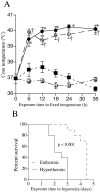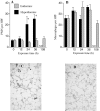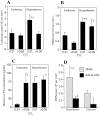Febrile-range hyperthermia augments pulmonary neutrophil recruitment and amplifies pulmonary oxygen toxicity
- PMID: 12759256
- PMCID: PMC1868125
- DOI: 10.1016/S0002-9440(10)64333-7
Febrile-range hyperthermia augments pulmonary neutrophil recruitment and amplifies pulmonary oxygen toxicity
Abstract
Febrile-range hyperthermia (FRH) improves survival in experimental infections by accelerating pathogen clearance, but may also increase collateral tissue injury. We hypothesized that FRH would worsen the outcome of inflammation stimulated by a non-replicating agonist and tested this hypothesis in a murine model of pulmonary oxygen toxicity. Using a conscious, temperature-controlled mouse model, we showed that maintaining a core temperature at FRH (39 degrees C to 40 degrees C) rather than at euthermic levels (36.5 degrees C to 37 degrees C) during hyperoxia exposure accelerated lethal pulmonary vascular endothelial injury, reduced the inspired oxygen threshold for lethality, induced expression of granulocyte-colony stimulating factor, and expanded the circulating neutrophil pool. In these same mice, FRH augmented pulmonary expression of the ELR(+) CXC chemokines, KC and LPS-induced CXC chemokine, enhanced recruitment of neutrophils, and changed the histological pattern of lung injury to a neutrophilic interstitial pneumonitis. Immunoblockade of CXC receptor-2 abrogated neutrophil recruitment, reduced pulmonary vascular injury, and delayed death. These combined data demonstrate that FRH may enlist distinct mediators and effector cells to profoundly shift the host response to a defined injurious stimulus, in part by augmenting delivery of neutrophils to sites of inflammation, such as may occur in infections. In certain conditions, such as in the hyperoxic lung, this process may be deleterious.
Figures









Similar articles
-
Febrile-range hyperthermia modifies endothelial and neutrophilic functions to promote extravasation.Am J Respir Cell Mol Biol. 2012 Jun;46(6):807-14. doi: 10.1165/rcmb.2011-0378OC. Epub 2012 Jan 26. Am J Respir Cell Mol Biol. 2012. PMID: 22281986 Free PMC article.
-
Febrile-range hyperthermia augments neutrophil accumulation and enhances lung injury in experimental gram-negative bacterial pneumonia.J Immunol. 2005 Mar 15;174(6):3676-85. doi: 10.4049/jimmunol.174.6.3676. J Immunol. 2005. PMID: 15749906
-
Prolonged exposure to hyperthermic stress augments neutrophil recruitment to lung during the post-exposure recovery period.Int J Hyperthermia. 2011;27(7):717-25. doi: 10.3109/02656736.2011.601528. Int J Hyperthermia. 2011. PMID: 21992563
-
Febrile-range hyperthermia augments lipopolysaccharide-induced lung injury by a mechanism of enhanced alveolar epithelial apoptosis.J Immunol. 2010 Apr 1;184(7):3801-13. doi: 10.4049/jimmunol.0903191. Epub 2010 Mar 3. J Immunol. 2010. PMID: 20200273 Free PMC article.
-
The effects of granulocyte colony-stimulating factor and neutrophil recruitment on the pulmonary chemokine response to intratracheal endotoxin.J Immunol. 2001 Jan 1;166(1):458-65. doi: 10.4049/jimmunol.166.1.458. J Immunol. 2001. PMID: 11123324
Cited by
-
Febrile-range hyperthermia modifies endothelial and neutrophilic functions to promote extravasation.Am J Respir Cell Mol Biol. 2012 Jun;46(6):807-14. doi: 10.1165/rcmb.2011-0378OC. Epub 2012 Jan 26. Am J Respir Cell Mol Biol. 2012. PMID: 22281986 Free PMC article.
-
Distinct, gene-specific effect of heat shock on heat shock factor-1 recruitment and gene expression of CXC chemokine genes.Cytokine. 2011 Apr;54(1):61-7. doi: 10.1016/j.cyto.2010.12.017. Epub 2011 Jan 26. Cytokine. 2011. PMID: 21266308 Free PMC article.
-
Experimental models and emerging hypotheses for acute lung injury.Crit Care Clin. 2011 Jul;27(3):735-52. doi: 10.1016/j.ccc.2011.05.013. Crit Care Clin. 2011. PMID: 21742226 Free PMC article. Review.
-
Pathological mechanisms of cold and mechanical stress in modulating cancer progression.Hum Cell. 2024 May;37(3):593-606. doi: 10.1007/s13577-024-01049-y. Epub 2024 Mar 27. Hum Cell. 2024. PMID: 38538930 Review.
-
Effect of a fever in viral infections - the 'Goldilocks' phenomenon?World J Clin Cases. 2021 Jan 16;9(2):296-307. doi: 10.12998/wjcc.v9.i2.296. World J Clin Cases. 2021. PMID: 33521098 Free PMC article. Review.
References
-
- Kluger MJ, Kozac W, Conn CA, Leon LR, Soszynski D: The adaptive value of fever. Mackowiak PA eds. Fever: Basic Mechanisms and Management. 1996:pp 255-266 Raven Press, New York
-
- Hasday JD, Fairchild KD, Shanholtz C: The role of fever in the infected hosts. Microbes and Infection 2000, 2:1891-1904 - PubMed
-
- Hasday JD, Fairchild KD, Shanholtz C: The role of fever in the infected host. Microbes and Infection 2000, 2:1-14 - PubMed
-
- Kuikka A, Sivonen A, Emelianova A, Valtonen VV: Prognostic factors associated with improved outcome of Escherichia coli bacteremia in a Finnish university hospital. Eur J Clin Microbiol Infect Dis 1997, 16:125-134 - PubMed
Publication types
MeSH terms
Substances
Grants and funding
LinkOut - more resources
Full Text Sources
Other Literature Sources
Medical

